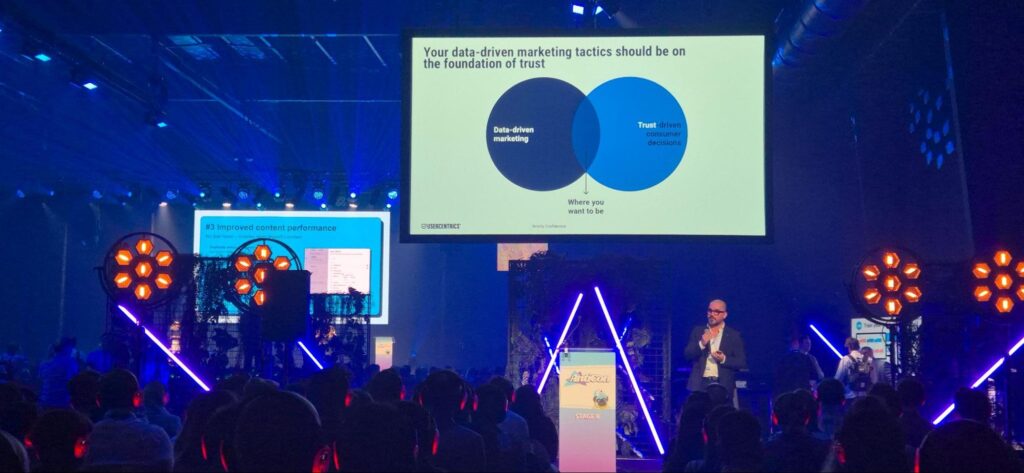Modern marketing has a consent problem, and most people don’t even know it exists.
No amount of advanced analytics, machine learning algorithms, or personalization engines can fix campaigns built on a foundation of manipulated or deceptive consent.
Yet that’s exactly what’s happening across the marketing industry today.
On stage at AntiCon, marketing technologists and experts demonstrated how artificial intelligence is revolutionizing the way we market and sell to people. The presentations were impressive.

Companies showed how they could predict their customer lifetime value and automatically segment audiences across different behavioral patterns. These insights enabled them to deliver personalized experiences that increased conversion rates exponentially. The room buzzed with excitement as attendees scribbled notes and snapped photos of the data visualizations on stage.
But amid all the talk of algorithms and machine learning models, one fundamental question went unasked: Where did all this data come from? More specifically, how was consent obtained from the millions of consumers whose behavioral patterns were being analyzed, segmented, and monetized?
There’s a growing consent gap in the marketing industry that’s quietly undermining even the most advanced data-driven strategies. While marketers have become increasingly sophisticated about what they do with consumer data, many remain surprisingly uninformed about how that data was collected in the first place.
The foundation everyone ignores
Modern marketing runs on data. Every click, scroll, purchase, and pause generates information that feeds into increasingly complex systems designed to understand and influence consumer behavior. Companies are investing heavily in advanced data analytics and web personalization, because they know that better customer insights drive better business results.
Yet this entire structure rests on the initial moment when consent was obtained. Most marketing professionals can explain the intricacies of lookalike audiences, predictive modeling, and attribution analysis. Few of them can explain how the underlying data was collected, what context was provided to consumers when they gave consent, or whether that consent was actually informed and freely given.
This gap has real consequences. Research from the Pew Research Center indicates that 81 percent of Americans feel they have little to no control over the data that companies collect about them, while 79 percent report being concerned about how their data is being used. When these consumers discover that their data was collected through deceptive or manipulative practices, the backlash can be swift and severe.
The sophistication paradox
The “sophistication paradox” refers to the contradictory nature of an industry that has mastered the science of data analysis while often overlooking the ethics of data collection.
The paradox captures how marketing teams can execute incredibly complex targeting and attribution while remaining uninformed about the origins of their data. Users become just numbers, not people.
Marketing teams that can run complex campaigns across dozens of channels often buy their data from providers who use digital tactics to get consent. Data brokers collect personal information through misleading cookie banners and vague privacy policies, then sell that data to marketers who never question how it was obtained.
Consider the following scenario. A consumer visits a website to read an article, encounters a cookie banner that appears for three seconds with pre-checked boxes and dark patterns designed to encourage clicking “accept,” and suddenly their browsing behavior is being used to build detailed psychological profiles for marketing purposes.
The paradox becomes even more concerning when you consider how consent is typically obtained versus how that data is used. A consumer might unknowingly consent to “improving website experience” and later discover their data is being used for targeted political advertising, insurance premium calculations, or employment screening.
This disconnect has led some companies to overhaul their data strategies completely. Marketing teams that initially worried about losing data volume are discovering that campaigns built on data that was collected transparently and with contextual consent actually perform better. When people genuinely want to share their information with brands, that data proves much more valuable than data extracted through manipulation.
The trust erosion effect
The consent gap raises legal and ethical concerns while actively undermining marketing effectiveness. When consumers feel deceived about how their data was collected, it creates a trust deficit that affects all subsequent interactions. This trust erosion appears in several ways that directly affect campaign performance.
First, consumers become increasingly defensive and skeptical of marketing messages when they suspect their data was obtained through deceptive means. Audiences who willingly gave their consent demonstrated higher engagement rates and better conversion performance compared to audiences whose data was collected in bulk. That means consumers who willingly share their data are more receptive to marketing communications.
Second, there’s the rise of “consent fatigue,” which is when consumers automatically reject all data collection requests due to past negative experiences and being overwhelmed by requests. This phenomenon makes it harder for legitimate marketers to obtain the permissions they need.
Third, regulatory scrutiny is intensifying. The General Data Protection Regulation (GDPR) has resulted in billions of euros in cumulative fines since its implementation, many related to improper consent practices. Recent cases, like one involving the popular app BeReal, highlight how regulators are focusing on consent quality, examining dark patterns and manipulative design in addition to technical compliance. Similar regulations are emerging globally, with enforcement agencies also paying closer attention to the quality of consent.
Perhaps most damaging is the long-term impact on customer relationships. Companies that build their marketing strategies on questionable consent practices often find themselves trapped in adversarial relationships with their customers, constantly trying to extract value rather than create it.
The real cost of cheap consent
Many marketers gravitate toward data sources that offer large volumes at low prices. But they don’t question why that data is so inexpensive. The answer is often that corners were cut during the consent collection process. Pre-checked boxes, confusing language, dark patterns, and buried opt-outs all reduce the cost of obtaining consent, but they also fundamentally compromise its validity and value.
Consider the economics: a dataset built on manipulative consent practices might cost USD 0.05 per record, while data collected through transparent, contextual consent might cost USD 0.50 per record.

The ten-fold price difference reflects the additional effort required to obtain real permission. But campaigns built on the more expensive data consistently outperform those using cheaper alternatives.
The hidden costs of questionable consent are substantial. Companies often discover that audiences built on manipulative consent data exhibit higher unsubscribe rates, lower engagement levels, and increased complaint rates. Customer service teams report more negative interactions. Brand perception surveys show decreased trust scores. Regulatory compliance teams face increased scrutiny and potential penalties.
Meanwhile, companies that invest in high-quality consent practices often find that their smaller, more expensive datasets deliver superior results. Consumers who have chosen to share their data are more receptive to marketing messages, more likely to engage with content, and more willing to make purchases.
The context problem
Even when consent is technically valid, many marketers overlook the vital element of context. A consumer who consents to data collection for “personalizing website content” has provided very different permission than one who explicitly agrees to “sharing data with advertising partners for targeted marketing across the internet.” Yet contextual differences are often ignored once data enters the marketing ecosystem.
The same research from Pew Research Center mentioned earlier found that consumers’ comfort levels with data usage vary dramatically based on the specific use case and context in which consent was obtained. Data collected for one purpose but used for another creates a sense of betrayal that can permanently damage customer relationships.
The problem is compounded by the fact that data often changes hands multiple times before reaching end marketers. Each transfer point is an opportunity for context to be lost or distorted. A consumer who provided limited consent to a retailer might find their data being used by dozens of other companies for purposes they never imagined or approved.
Breaking the cycle
The most successful companies are those that break out of the consent gap by demonstrating as much care about where their data comes from as how they use it. This means asking hard questions about data sources, implementing systems to track consent context throughout the data lifecycle, and making consent quality a key performance indicator, not an afterthought.
Progressive marketing teams are beginning to check their data sources as carefully as they check their ads or technology. They’re demanding transparency from data providers about consent collection practices. They’re implementing consent management platforms that preserve context and purpose limitations. Most importantly, they’re recognizing that high-quality consent is a competitive advantage rather than an expensive privacy compliance burden.
This mindset shift is transforming how successful companies approach marketing effectiveness. Instead of optimizing for data volume, they optimize for data quality and consent validity. Instead of treating privacy as a constraint, they treat it as a differentiator. Instead of trying to extract maximum value from each consumer interaction, they focus on building sustainable, trust-based relationships.
The technology solution
Technology plays a crucial role in bridging the consent gap, but not in the way many marketers may think. Rather than using technology to make consent collection more efficient or less noticeable, leading companies use it to make consent more transparent, granular, and meaningful.
Modern consent management platforms can preserve the full context of how consent was obtained. That includes its specific purpose, the exact language used, and what alternatives were presented to consumers. This information travels with the data throughout its lifecycle, so marketers can verify that their usage remains aligned with the original consent.
Advanced systems can also enable dynamic consent, which means consumers can modify their preferences over time as their comfort levels and interests change. This ongoing dialogue often results in higher overall consent rates because consumers feel empowered rather than trapped by their initial decisions.
Machine learning algorithms can help identify patterns that suggest consent fatigue or manipulation, which enables companies to refine their approaches. Predictive models can estimate the likely lifetime value of different consent scenarios to help marketers understand the long-term benefits of investing in high-quality consent practices.
Perhaps most importantly, technology can make consent more granular and purpose-specific. Instead of requesting broad permission for undefined future uses, companies can ask for specific, limited consent for particular purposes. This approach not only provides better legal protection but also supports more targeted and effective marketing campaigns.
Building a privacy-led culture
Addressing the consent gap demands a cultural shift within marketing organizations. This means educating marketing teams about privacy principles, incorporating consent quality into performance metrics, and making data ethics a core competency rather than a specialized skill.
Companies that thrive will be those implementing training programs that help marketers understand the connection between consent practices and campaign performance. They’re the ones creating cross-functional teams that include privacy experts, legal counsel, and compliance specialists alongside traditional marketing roles. They’re developing decision-making frameworks that consider consent implications at every stage of campaign development, and implementing Privacy-Led Marketing strategies.

This cultural change will require redefining success metrics. Traditional marketing KPIs like reach, impressions, and cost-per-click tell only part of the story. Companies serious about addressing the consent gap supplement these metrics with consent quality scores, trust indicators, and long-term relationship health measures.
Organizations could benefit from developing consent scorecards that rate data sources based on the transparency, context, and validity of the consent obtained. These scorecards could inform procurement decisions, campaign planning, and performance analysis. Over time, they would help create a marketplace where high-quality consent practices are rewarded.
The competitive advantage
Companies that successfully bridge the consent gap often discover that privacy compliance is a significant competitive advantage. As consumers become increasingly concerned about data privacy, transparent consent practices can differentiate brands and build customer loyalty.
Organizations that prioritize consent quality tend to see better campaign performance because their marketing is built on a foundation of trust rather than extraction. When consumers genuinely choose to share their data, they’re more likely to engage with marketing messages and develop lasting brand relationships.
These companies are also better positioned for the future regulatory environment. As privacy laws become more stringent globally, organizations with strong consent practices will face lower compliance costs and reduced regulatory risk. They’ll also be better prepared to adapt to new requirements because their systems and processes already prioritize consent quality.
As regulations tighten and consumer awareness grows, the path toward competitive advantage through privacy is becoming clear. Companies that understand this shift early will have significant advantages in customer acquisition, retention, and lifetime value.
The path forward
The consent gap represents both a challenge and an opportunity for the marketing industry. The challenge lies in overcoming years of practices that prioritized data volume over consent quality. The opportunity lies in building more sustainable, effective, and ethical marketing strategies that create value for both companies and consumers.
To close this gap, companies must recognize that consent isn’t just a legal checkbox. It’s the foundation of customer trust and marketing effectiveness. It means asking hard questions about data sources, implementing systems that preserve consent context, and treating privacy as a competitive advantage rather than a compliance burden.
The marketing industry is at a crossroads. Companies can continue using advanced targeting built on shaky data sources, but they’ll face growing risks and worse results. Instead, they can invest in bridging the consent gap, building Privacy-Led Marketing strategies that are not only more ethical but also more effective.
The choice is clear. As consumers become more conscious about their privacy and regulations become more stringent, the consent gap will only become more problematic for companies that ignore it. Those that address it proactively will find themselves with stronger customer relationships, better campaign performance, and more sustainable business models.
The conversations happening at conferences like AntiCon about AI, automation, and data sophistication are critical for the industry’s future. But they represent only half of the equation. The other half is making sure that the data feeding these complex systems was obtained through transparent, contextual, and genuine consent, and it’s equally important.
Marketing professionals who embrace this challenge won’t just be building better campaigns. They’ll be building better relationships with their customers and a more sustainable future for the industry as a whole. The consent gap may seem like a technical privacy issue, but it’s really a fundamental business challenge that goes to the heart of what marketing should be about: creating value for consumers while building profitable relationships based on trust.

